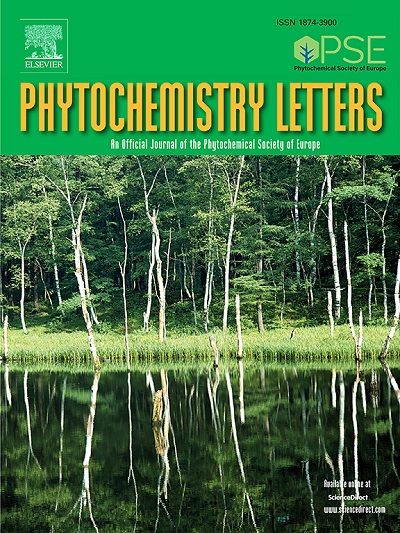高氯酸镍催化合成芳基亚甲基双吲哚的研究
IF 1.4
4区 生物学
Q4 CHEMISTRY, MEDICINAL
引用次数: 0
摘要
芳基亚甲基双吲哚生物碱主要存在于十字花科植物中,并作为海洋生物的代谢物存在,具有多种生物活性。近年来,这些生物碱在防治植物病原真菌方面得到了越来越多的探索和利用。然而,其合成和潜在的机制,特别是其对植物病原体(如克拉丽迪雅)的有效性仍需进一步研究。本研究以NiClO4·6H2O为催化剂,以芳香醛和吲哚为原料,高收率合成了一系列芳基亚甲基双吲哚。这些化合物对6种主要植物病原真菌均有抑菌活性,其中A13对同质果霉的抑菌活性最高,EC50值为0.74 mg/L。此外,还进行了体内抗真菌试验,以评估活性化合物对同质香霉的抑菌效果。为了阐明芳基亚甲基双吲哚的抗真菌机制,我们通过生理生化指标的综合分析和转录组分析来阐明其抗真菌机制。结果表明,A13处理能有效地破坏同质香柏的细胞膜。此外,我们鉴定并筛选了A13处理下与细胞膜改变有关的候选基因。KEGG通路分析显示,相当一部分下调的deg在真核生物的代谢途径、次生代谢生物合成和核糖体生物发生中显著富集。本研究为草坪斑病的有效治理提供了有价值的见解。本文章由计算机程序翻译,如有差异,请以英文原文为准。
The synthesis of arylmethylene bisindoles catalyzed by nickel perchlorate as potential antifungal agent against Clarireedia homoeocarpa
Arylmethylene bisindole alkaloids are predominantly found in cruciferous plants and as metabolites in marine organisms, exhibiting a diverse range of biological activities. In recent years, these alkaloids have been increasingly explored and utilized for controlling plant pathogenic fungi. However, the synthesis and underlying mechanisms, particularly their effectiveness against plant pathogens such as Clarireedia homoeocarpa, still require further investigation. In this study, a series of arylmethylene bisindoles were synthesized with high yield using aromatic aldehydes and indoles catalyzed by NiClO4·6H2O. These compounds showed spectral antibacterial activity against six major phytopathogenic fungi and A13 exhibiting the highest antifungal activity against C. homoeocarpa with an EC50 value of 0.74 mg/L. Furthermore, in vivo antifungal assays were performed to assess the efficacy of the active compounds against C. homoeocarpa. To elucidate the antifungal mechanism of arylmethylene bisindoles, a comprehensive analysis of physiological and biochemical indices, along with transcriptome profiling, was carried out to elucidate. The results demonstrated that A13 treatment can efficiently disrupt the cell membranes of C. homoeocarpa. Additionally, we identified and screened the candidate genes implicated in cell membrane alterations under A13 treatments. KEGG pathway analysis revealed that a considerable number of down-regulated DEGs were significantly enriched in metabolic pathways, biosynthesis of secondary metabolic, and ribosome biogenesis in eukaryotes. This research provides valuable insights for the effective management of lawn coin spot disease.
求助全文
通过发布文献求助,成功后即可免费获取论文全文。
去求助
来源期刊

Phytochemistry Letters
生物-生化与分子生物学
CiteScore
3.00
自引率
11.80%
发文量
190
审稿时长
34 days
期刊介绍:
Phytochemistry Letters invites rapid communications on all aspects of natural product research including:
• Structural elucidation of natural products
• Analytical evaluation of herbal medicines
• Clinical efficacy, safety and pharmacovigilance of herbal medicines
• Natural product biosynthesis
• Natural product synthesis and chemical modification
• Natural product metabolism
• Chemical ecology
• Biotechnology
• Bioassay-guided isolation
• Pharmacognosy
• Pharmacology of natural products
• Metabolomics
• Ethnobotany and traditional usage
• Genetics of natural products
Manuscripts that detail the isolation of just one new compound are not substantial enough to be sent out of review and are out of scope. Furthermore, where pharmacology has been performed on one new compound to increase the amount of novel data, the pharmacology must be substantial and/or related to the medicinal use of the producing organism.
 求助内容:
求助内容: 应助结果提醒方式:
应助结果提醒方式:


